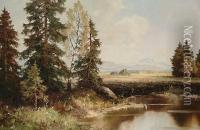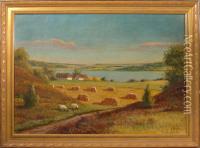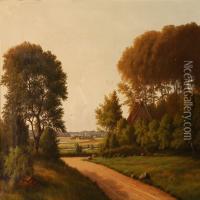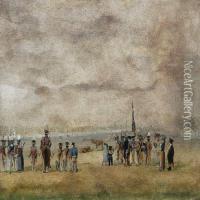Johan Wilhelm Ludwig Dahl Paintings
Johan Christian Dahl, often known as J.C. Dahl or I.C. Dahl, was a Norwegian painter born on February 24, 1788, in Bergen, Norway. He is considered one of the greatest landscape painters in Norway and is often regarded as the 'father of Norwegian landscape painting'. Dahl's work played a crucial role in establishing a distinctly Norwegian bent in the fine arts, and he is associated with the Romantic movement, though his style also incorporated aspects of Realism.
Dahl's early life was modest; his father was a fisherman, and he initially started his career as a painter by decorating ships and homes. He studied at the Royal Danish Academy of Fine Arts in Copenhagen, where he was influenced by the teachings of Christian August Lorentzen and Jens Juel. His landscapes from this period are characterized by a meticulous and somewhat rigid technique in the neoclassical tradition.
In 1818, Dahl moved to Dresden, Germany, where he would spend much of his professional life. There, he became a friend and collaborator of the famous German Romantic landscape painter Caspar David Friedrich. Friedrich's influence can be seen in the emotional depth and atmospheric moodiness of Dahl's later works. Despite living in Germany, Dahl's subject matter often remained focused on the Norwegian landscape, which he would revisit during his summer trips back to Norway.
Dahl's approach to landscape painting was innovative for his time; he often sketched from nature, capturing the changing light and weather conditions, and then worked on these sketches in his studio. His landscapes became known for their grandeur and dramatic use of natural light, often depicting the rugged beauty of Norway's countryside and fjords. Dahl's work helped to elevate landscape painting as a genre, which had previously been considered inferior to historical painting.
Notable works by J.C. Dahl include 'View of Dresden by Moonlight', 'The Eruption of Vesuvius', and 'Bjerk i storm' (Birch in a Storm). He also painted portraits and had a significant role in the preservation of Norwegian historical monuments and buildings. He was a professor at the Dresden Academy and influenced a number of younger artists.
Dahl's contribution to art was not only through his paintings but also through his influence on future generations of Norwegian artists. His emphasis on painting the natural beauty of the Norwegian landscape with emotional resonance and a sense of national identity was a source of inspiration for many.
Johan Christian Dahl passed away on October 14, 1857, in Dresden, leaving behind a legacy that would resonate through Norwegian culture and history. His works are held in high esteem and can be found in major museums in Norway, including the National Gallery in Oslo, as well as international art collections.




